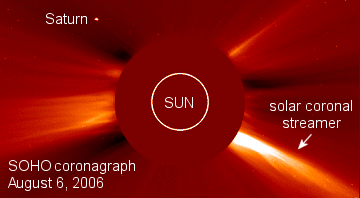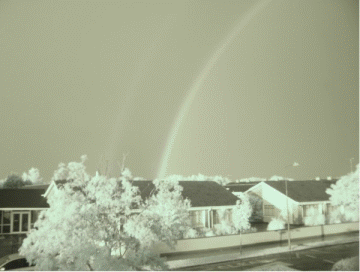 Would you like a call the next time a geomagnetic storm erupts? Sign up for Spaceweather PHONE.
Would you like a call the next time a geomagnetic storm erupts? Sign up for Spaceweather PHONE.
SOLAR GEOGRAPHY: Wouldn't it be nice if the sun you saw through your solar telescope had the equator labeled and the poles marked? A new computer program from Les Cowley can help you sort out solar geography. It's called TiltingSun: free download.
SUNNY SATURN: Looking for Saturn? Don't. It could hurt your eyes: The ringed planet is right beside the sun.
Saturn is passing by the sun this weekend, and only SOHO can see the encounter. Coronagraphs onboard the spacecraft block the sun's glare to reveal whatever is nearby:

SOHO coronagraph image: August 6, 2006 @ 2006 UT
Of course, Saturn is not truly "beside the sun." It's on the far side of the solar system, 1.4 billion kilometers from the sun. The two bodies merely seem close together as viewed from Earth. Click here for the latest images.
INFRARED DOUBLE RAINBOW: Lately, so many rainbows have popped up around Dublin, Ireland, locals have coined a new phrase: "We call it rainbow pollution," laughs Brian Nitz.
After a recent thundershower, Nitz photographed a bright double rainbow. In one exposure, he used an infra-red filter. In another exposure, he didn't. The resulting blink comparison shows the rainbow in visible vs. infrared light:

Individual images: infra-red vs. visible. Credit: Brian Nitz of Dublin, Ireland.
Note how the infra-red 'bows are closer together than the visible 'bows. Also, the infrared arcs fit neatly inside their visible counterparts. This happens because the wavelength of infrared light is longer than the wavelength of visible light. Rainbows are formed by light reflecting inside raindrops. Different wavelengths mean different angles of reflection--and different-sized rainbows.

